Drug use among teens falls to historic low amid fears about fentanyl, NIH report shows
Illegal and legal drug use among American schoolchildren has fallen to a record low, according to an official report.
Officials from the National Institute on Drug Abuse surveyed a nationally representative sample of 22,000 students in nearly every state this year.
They found that a third of twelfth graders have used illegal drugs in the past year – up from 40 percent in 2000.
Of 10th graders, 19.8 percent admitted to using the substances – up from 35.9 percent in 2000 – and of 8th graders, 10.9 percent said they used them – down from the 20.9 percent twenty years ago.
The use of legal drugs such as alcohol and nicotine has also fallen across all grades, even as it has become increasingly common to see vaping on playgrounds.
The above shows the proportions of 12th, 10th, and 8th grade students who admitted to using certain drugs in the past year. The data is for 2023
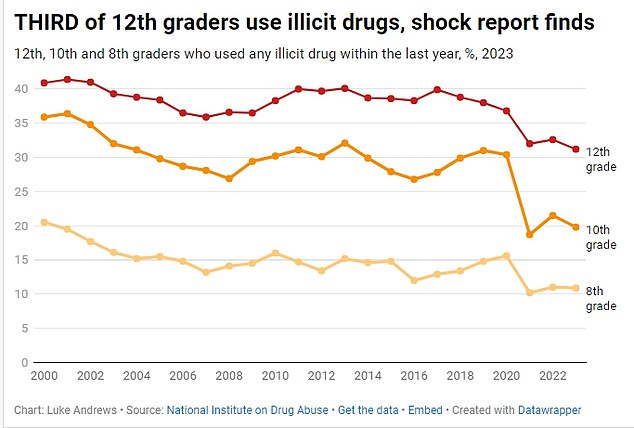
The above shows the share of students in each grade estimated to have used at least one illicit drug, including marijuana, since 2000.
But Dr. Nora Volkow, head of the agency behind the results, said the drop in drug use started during Covid, when lockdowns limited children's access to it.
Dr. Volkow said, “Research has shown that delaying substance use among young people, even by a year, can reduce substance use for the rest of their lives.
“Maybe we'll see this happen in real time.
“This trend is reassuring,” she added. “However, it remains crucial to educate young people about the risks and harms of substance use.”
Other factors leading to lower drug use may be the most important public health warnings against fentanyl.
The drug is repeatedly mixed with a variety of illegal street drugs to give users a more intense high, as the drug is up to 50 times stronger than heroin.
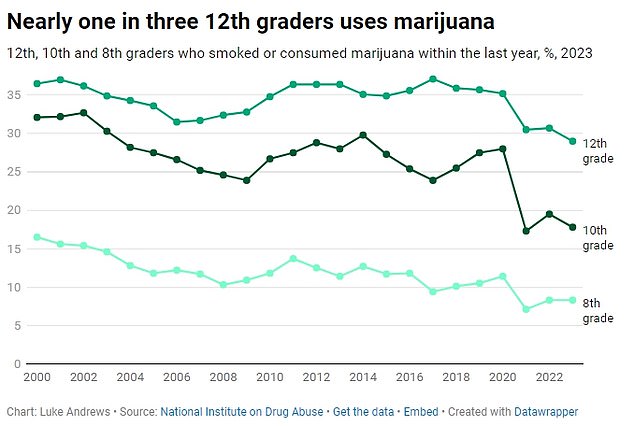
The above shows the percentage of students in three classes estimated to have used marijuana at least once a year since 2000
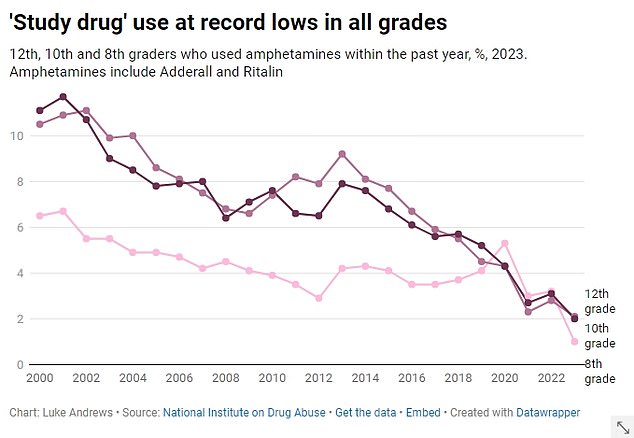
The above shows that the use of amphetamines, such as Adderall and Ritalin, has now fallen to a record low in all classes. Some students need to take these medications to help with conditions such as ADHD (Attention Deficit Hyperactivity Disorder)
The new drug data came from the Monitoring the Future survey, which surveys 12th, 10th and 8th grade students on a variety of topics, including their drug use.
The survey has been running since 1975 and has been distributed to 222 schools in almost every state in the US.
The answers are anonymous, encouraging students to disclose drug use, although they are also self-reported – with no evidence required to support the answers.
Children answered questions about their drug use, including the type of drugs used between February and June this year.
Children in 12th grade are 17 to 18 years old, while those in 10th grade are 15 to 16 years old and those in 8th are 13 to 14 years old.
The results showed that 31.2 percent of 12th grade students admitted to using illegal substances, including marijuana, in 2023.
This was down slightly from 32.6 percent last year and was the lowest figure since 1992 – but still high overall.
Among 10th graders, 19.8 percent admitted to using illegal substances in the past year, compared to 10.9 percent for 8th graders.
When it comes to marijuana, 29 percent of 12th graders said they had used the drug in the past year — either by smoking it or consuming edibles.
This was also down from 30.7 percent the year before, but still far from the low point in 1992, when 21.9 percent of young people admitted to the habit.
Experts also warn that marijuana is much more potent now than it was 20 years ago, thanks to a wave of recreational legalizations across the country.
This increases the risk of side effects and dangerous reactions, including seizures and psychosis, which can cause people to harm themselves or others.
Top officials warn that the wave of legalizations has led to the false perception that marijuana is safe to use, adding that the drug is especially dangerous in children and young adults because it can hinder brain development.
Statistics also showed that 17.8 percent of 10th graders also admitted to using weed – up from 19.5 percent in 2022 – and among 8th graders it was 8.3 percent – which was flat compared to the same time last year.
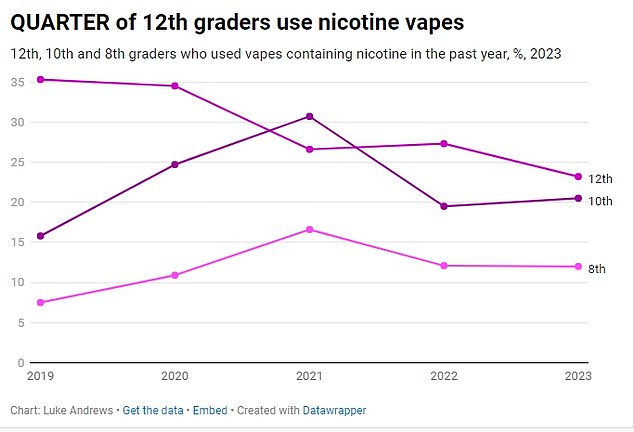
The above shows the share of students in grades 12, 10, and 8 who used nicotine vaping annually since 2019
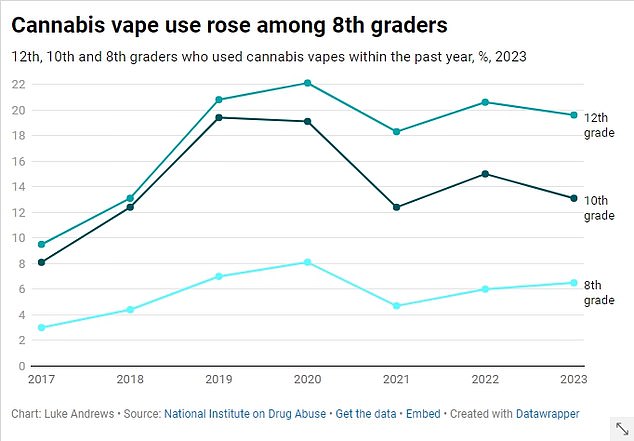
The above shows the proportion of students in 12th, 10th and 8th grades who used cannabis vapes annually since 2017
The figures on vaping are divided into those who vape with nicotine and those who vape with cannabis.
These statistics also remained stable compared to last year, officials said, with about 23.2 percent of 12th graders using nicotine vapes and 19.6 percent using cannabis vapes.
Among 10th graders the figures were 20.5 percent and 13.1 percent – while among 8th graders they were 12 and 6.5 percent.
There are major concerns about the health risks of vaping, including damage to the lungs. Data is now emerging that suggests the devices are no better than cigarettes.
The World Health Organization is now calling for a ban on flavored vape devices, saying they should be returned to their use to help people quit smoking.
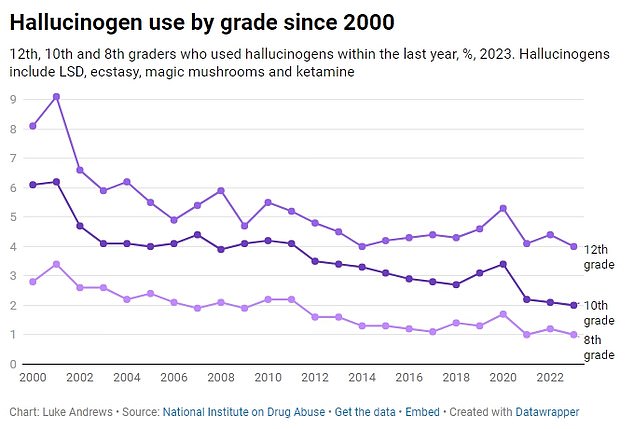
The above shows the percentage of students in 12th, 10th and 8th grades estimated to have used hallucinogens – LSD, ecstasy and magic mushrooms – at least once in the past year since 2000.
The study also included data on amphetamines – or study drugs – such as Adderall and Ritalin.
This proved to be a major public health success story, with the number of year 12 students admitting to using them in the past year falling again to 2.1 percent, down from 2.8 percent the year before.
Its use has declined almost every year since 2002, when one in ten 12th graders used it.
The drugs were popularized by many universities, where students used them to “stay all night” and feel “more focused” during exams.
However, studies have shown that while they can help people feel more alert, the quality of the work they produce is often poorer. Users have also revealed how they became addicted to the drugs, which are destroying their future prospects.
Many of the children now reporting using them in schools are believed to help manage conditions such as ADHD (Attention Deficit Hyperactive Disorder).
The data from tenth graders shows that two percent admit to using them in the past year, while among eighth graders the figure is only one percent.
Among the participants, a total of 41 percent had a white ethnic background.
Twenty-five percent were Hispanic, while 13 percent were black or African American, three percent Asian, and one percent American Indian. About 16 percent identified as more than one ethnicity.
